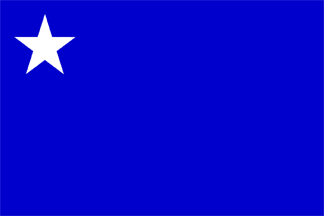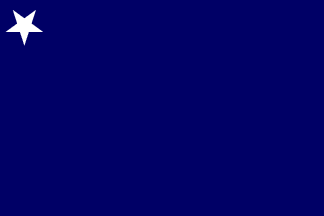 image by Tomislav Todorović, 24 October 2017
image by Tomislav Todorović, 24 October 2017
Last modified: 2020-12-26 by rob raeside
Keywords: plra | partido liberal radical auténtico |
Links: FOTW homepage |
search |
disclaimer and copyright |
write us |
mirrors
 image by Tomislav Todorović, 24 October 2017
image by Tomislav Todorović, 24 October 2017
See also:
Other sites:
The P.L.R.A. was founded on 10 July 1887 in Asunción as
Centro Democrático, presided by Antonio Taboada, a hero
of the war against the Triple Alliance (Brazil,
Argentina and Uruguay).
It governed Paraguay from 17 December 1904 to 17 February 1936. The
party was renamed Partido Liberal in 1890, Partido Liberal
Radical in 1967, and Partido Liberal Radical
Auténtico in 1978.
Ivan Sache, 24 May 2010
Under the Stroessner regime, Paraguay was a single-party state. The
original Partido Liberal was made illegal and many members fled into
exile. Eventually, Stroessner allowed opposition parties to exist legally
again, as long as they recognized the authority of his own
Partido Colorado. The Partido Liberal thus
split into a radical faction who rejected the second-rate status, and a
faction who returned to politics within the new system. The radical
faction went on to officially add the Radical moniker to the party name,
as mentioned.
Alex Garofolo, 24 June 2014
The flag of P.L.R.A. is described in the preamble of the party’s statutes, last amended 7 May 2006:
and as its emblem the blue flag with a five-pointed star placed in upper hoist, the first flag of the motherland at the dawn of its independence.The flag alluded to in the party’s statutes must be the short-lived flag used in 1811.
The flag of the Radical Liberals is also very similar to that of the
Dr Francia presidency, 1826-1842.
Alex Garofolo, 24 June 2014.
The party website currently displays,
as part of the header of all pages, the
image
of party flag with the upright star; a photo
confirms this design.
Tomislav Todorović, 23 September 2016
Regarding the shade of blue, the images currently available on the web,
regardless of the visible details of design, reveal that the field is
about the same shade as blue in the national
flag.
Tomislav Todorović, 23 September 2016
The
official
party image uses plain RGB:0-0-255 (![]() ).
).
António Martins, 21 October 2017
Although plain, «primary» blue is prescribed for the
national flag in the 2013
decree, we do know that the Liberal party is identified by a darker
shade, contrasting with M.P.Q.’s
light blue. Furthermore there is a history of distinguishing
“azul” (blue) from “celeste”
(lit., sky blue, meaning light blue) in this part of the word (cp. the
Federal / Unitarian feud in Argentina
and how it reflected on the realization of the national flag there). This
would support a “primary” blue color to be
actually “off-balanced” towards dark.
António Martins, 22 October 2017
The colour seems to be the important thing, with
design being secondary. Here are two
captures from the brief report
which appeared on World News Today on BBC4 tv on 21 April 2008:
Supporters of the PLRA, which uses dark blue, are shown in these shots
waving vigorously (too vigorously for detailed analysis) at least
three types of blue flag, all of them different from
what we show.
André Coutanche, 22 April 2008
The cover of the party’s ideological statement (image) shows a flag with lettering as its main illustration; also shown:
![[flag]](../images/p/py}lib0.gif) image by António Martins, 22 October 2017
image by António Martins, 22 October 2017
Here from a report on World
News Today (BBC4, 21 April 2008): Supporters of the PLRA, waving blue
flags, all of them different: One is a plain blue flag.
André Coutanche, 22 April 2008
A plain blue flag (an actual flag, not a drawing) for the party also
shows in this
promotional party video.
António Martins, 22 October 2017
![[flag]](../images/p/py}lib3.gif) image by António Martins, 23 October 2017
image by António Martins, 23 October 2017
Here from a report on World
News Today (BBC4, 21 April 2008): Supporters of the PLRA, waving blue
flags, all of them different: One has the initials between lines.
André Coutanche, 22 April 2008
This is the P.L.R.A. logo (used at least in 2008-2012), including a
“hand-drawn” star outline, pointing down (or at least not
clearly up);
here’s
some
images,
also as
used
on flags.
António Martins, 21 October 2017
![[flag]](../images/p/py}lib1.gif) image by António Martins, 23 October 2017
image by António Martins, 23 October 2017
A blue flag with a small white star on the upper hoist and the letters
"P.L.R.A." in very large white sans serif capitals, with abbreviation dots,
set slightly off to the bottom fly.
António Martins, 23 Oct 2017
This old illustration (however accurate in representing an actual flag)
was for some reason chosen to illustrate what seems to be a recent/current
party
document
(cover
image).
António Martins, 22 October 2017
This version of the flag, however old-style looking, must be later than
1978, when the party adopted its current name — not old for a party
founded in 1887!
António Martins, 23 October 2017
![[flag]](../images/p/py}lib5.gif) image by António Martins, 24 October 2017
image by António Martins, 24 October 2017
Here from a report on World
News Today (BBC4, 21 April 2008): Supporters of the PLRA, waving blue
flags, all of them different: One has a star and the initials.
André Coutanche, 22 April 2008
A blue flag, apparently more squarish, around 2:3 or less, with
slightly arched (?) "P.L.R.A." in bold white sans serif capitals, with
dots, above a white star, everything centered.
António Martins, 24 October 2017
![[flag]](../images/p/py}lib4.gif) image by António Martins, 27 Oct 2017
image by António Martins, 27 Oct 2017
Among many others,
this
image online shows, besides the star, also the slogan "LIBERALES
DIGNOS" (meaning something like dignified, or honest, or righteous,
or even worthy — Liberals) in white sans serif bold compact capitals.
I’m not sure how much this is an insignificant one-off (or even
whether it is a an actual flag at all).
António Martins, 27 October 2017
 image by Guillermo Tell Aveledo, 21 October 2017
image by Guillermo Tell Aveledo, 21 October 2017
The flag seems to be incorrect: The star is shown upside-down,
and blue color is too dark. This may have been derived from the
party
Tomislav Todorović, 23 September 2016
The current logo (used at least in 2008-2012)
is different, with a “hand-drawn” star outline,
but indeed still pointing down. The cover of the party’s
ideological
statement
(image)
shows a flag on a slanted staff.
António Martins, 21 October 2017